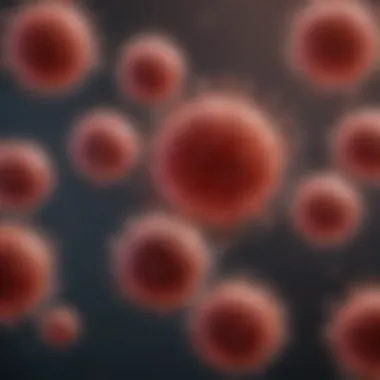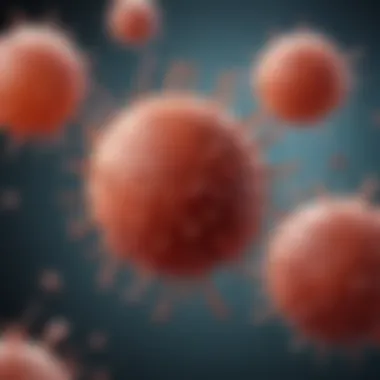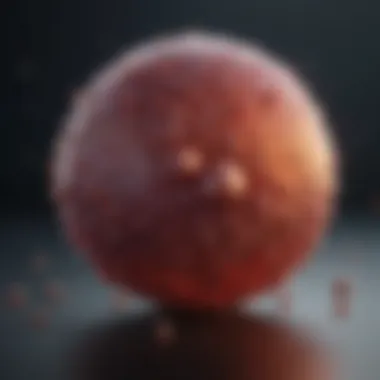Lymphocyte Separation Medium: Key Insights and Innovations


Intro
Lymphocytes are crucial components of the immune system. They play significant roles in the body's defense mechanisms against pathogens. The study of these cells has been foundational in immunology and cellular biology. In various research settings, the need for effective methods to isolate lymphocytes from other blood components is imperative. This is where lymphocyte separation medium comes into play, acting as a vital tool in facilitating the isolation process.
Understanding the intricacies of lymphocyte separation medium is essential. This article will cover its definition, composition, scientific principles, current trends, and future innovations. The objective is to provide a comprehensive guide that is both informative and insightful for students, researchers, educators, and professionals alike.
Key Concepts
Definition of the Main Idea
Lymphocyte separation medium refers to a specific solution designed to isolate lymphocytes from whole blood or other biological samples. This medium utilizes density gradient centrifugation principles, allowing for the effective separation of lymphocytes based on their physical properties. The primary aim of using such a medium is to enrich lymphocyte populations for subsequent analyses or applications in research and clinical settings.
Overview of Scientific Principles
At its core, the lymphocyte separation process relies on the principles of centrifugation and density gradient techniques. These methods exploit differences in cell density. The most common types of media include Ficoll-Paque and Histopaque. These solutions are primarily composed of polysaccharides that create a gradient when centrifuged, allowing for the stratification of various cell types.
The process typically involves the following steps:
- Sample Preparation: The whole blood sample is diluted with a saline solution before adding the separation medium.
- Centrifugation: The sample is then subjected to high-speed centrifugation, leading to the separation of lymphocytes by density.
- Layer Removal: After centrifugation, the lymphocyte layer can be carefully collected for further analysis.
Integrating well-defined protocols with suitable separation media enhances the efficiency and reliability of lymphocyte isolation.
An effective lymphocyte separation medium can significantly improve the quality of results obtained from downstream applications such as flow cytometry, cell culture, and immunological assays.
An effective lymphocyte separation medium can significantly improve the quality of results obtained from downstream applications such as flow cytometry, cell culture, and immunological assays.
Current Research Trends
Recent Studies and Findings
Recent advancements in the domain of lymphocyte separation have focused on improving purity and yield. Studies indicate that variations in centrifugation speed and time may lead to better outcomes in terms of cell viability. Significant research has also been aimed at developing new media formulations that can accelerate the isolation process while reducing potential cellular stress.
Significant Breakthroughs in the Field
Technological breakthroughs, including automated cell isolation systems, are transforming lymphocyte separation methodologies. These systems often integrate advanced protocols with higher precision and throughput. Innovations such as lab-on-a-chip technologies, which enable rapid analysis and processing, also show promise in streamlining lymphocyte separation tasks.
Such advancements not only improve laboratory efficiency but also expand the applications of lymphocyte studies in clinical diagnostics and therapeutic interventions.
Prologue to Lymphocyte Separation Medium
Lymphocyte separation medium plays a critical role in both research and clinical applications involving the immune system. This medium is primarily used for isolating lymphocytes from whole blood or other tissue sources. Understanding its composition and function is essential for researchers and healthcare professionals who aim to study immune responses or develop therapeutic strategies. The importance of lymphocyte separation medium lies in its ability to provide a uniform and reliable source of immune cells, which are crucial for a variety of experimental procedures.
Definition and Purpose
Lymphocyte separation medium refers to a specialized solution formulated to isolate lymphocyte cells from blood samples. Its primary purpose is to separate various types of blood cells based on their density and size through a process known as density gradient centrifugation. This results in a virtually pure layer of lymphocytes, which scientists can utilize for further analysis, laboratory experiments, or clinical applications. By harnessing this separation medium, researchers can delve into the intricacies of immune function and response, leading to advancements in fields such as immunology, vaccine development, and cancer research.
Historical Background
The history of lymphocyte separation medium dates back to the mid-20th century, coinciding with major advancements in cell biology. Initially, separation techniques relied on simple sedimentation methods, which were inefficient and produced poor yields of viable cells. With the advent of density gradient centrifugation, the process became more refined.Known materials such as Ficoll have emerged as key components in these media, enhancing the separation process. Over the decades, improvements and innovations in separation techniques have facilitated breakthroughs in understanding the immune system. Today, lymphocyte separation media is a standardized reagent in laboratories, streamlining various experiments and enabling researchers to address complex questions within the biological sciences.
Composition of Lymphocyte Separation Medium
The composition of lymphocyte separation medium is central to its effectiveness and efficiency in isolating lymphocytes. A well-formulated medium ensures that cells retain their viability and functionality during the separation process. The specific components included in the medium play a significant role in achieving high separation fidelity. Understanding these ingredients helps to optimize protocols and improves outcomes in both research and clinical settings.
Key Ingredients


Ficoll
Ficoll is a polysaccharide that serves as a crucial element in lymphocyte separation media. Its primary contribution lies in its density, which allows for the creation of density gradients essential for cell separation. Ficoll is widely used because of its inertness and minimal interference with cellular functions. The unique feature of Ficoll is its solubility in aqueous solutions, which facilitates seamless mixing and pipetting during protocol execution. However, one disadvantage is that it can affect the buoyancy of certain cell types if used inappropriately, potentially leading to poor recovery rates.
Density Gradients
Density gradients are a fundamental aspect of lymphocyte separation. By establishing layers of varying densities in the medium, researchers can exploit the physical characteristics of different cell types. This method selectively isolates lymphocytes based on their density, offering a reliable means of separation. One significant advantage of density gradients is their precision in targeting specific cell types while minimizing contamination with other cells. However, there is a need for careful setup, as insufficient gradient formation can lead to overlapping cell layers and reduce separation quality.
Nutritional Components
The nutritional components included in lymphocyte separation media are critical for maintaining cell viability throughout the procedure. These components often comprise amino acids, vitamins, and salts, all vital for optimal cell growth and function. Nutritional components are beneficial because they support cellular metabolism during isolation, ensuring that lymphocytes remain functional for downstream applications. A unique feature of these components is their ability to buffer against environmental changes during the separation process. Nonetheless, excessive or imbalanced nutritional factors can lead to cellular stress, highlighting the importance of precise formulation.
Physiochemical Properties
Physicochemical properties such as viscosity, osmolarity, and pH levels play a pivotal role in the behavior and effectiveness of lymphocyte separation media.
Viscosity
Viscosity refers to the thickness of a liquid and influences how components within the separation medium interact. High viscosity can impede the movement of cells, making isolation less effective. The key characteristic of an ideal viscosity level is that it must be low enough to allow smooth cell flow but high enough to maintain the integrity of separation layers. A significant advantage of controlled viscosity is that it ensures better separation efficiency. However, maintaining optimal viscosity can require precise adjustments and careful monitoring of medium components.
Osmolarity
Osmolarity affects osmotic pressure within the medium and is crucial for cell integrity. Maintaining appropriate osmolarity levels ensures that lymphocytes do not undergo osmotic shock, which can lead to cell lysis or dehydration. The key feature of osmolarity in this context is its correlation with cellular homeostasis. An advantage of closely monitored osmolarity is improved cell survival rates during separation. Conversely, incorrect osmolarity can result in poor recovery of target lymphocytes.
pH Levels
Maintaining pH levels is vital for ensuring enzymatic and metabolic activity of lymphocytes. The ideal pH range for lymphocyte separation media typically lies between 7.2 and 7.4. This range supports cellular function and minimizes stress during isolation. A unique aspect of pH control is its direct impact on the overall environment where cells are suspended. Proper pH levels can enhance cell viability, whereas deviations can lead to compromise in lymphocyte quality. Careful adjustment of pH using buffering agents is thus essential, yet improper adjustments can have detrimental effects on cell yield.
Mechanism of Lymphocyte Separation
Understanding the mechanism of lymphocyte separation is crucial to appreciating how effective this process can be in various applications, especially within immunology and cellular biology. At its core, this mechanism relies heavily on the principles of density gradient centrifugation, which separates lymphocytes from other cell types based on their density. This leads to purified populations of cells, essential for both research and clinical purposes.
Density Gradient Centrifugation
Density gradient centrifugation is a widely used technique that allows for the stratification of cells based on their densities. During this process, a sample containing mixed cell types is layered over a medium that has a specific density, often containing Ficoll or similar substances. The centrifugation applies a force that causes denser cells to migrate deeper into the gradient. Lymphocytes, having a specific density, accumulate at a certain level within the gradient, effectively separating them from other cells, such as erythrocytes or granulocytes.
This method has shown to be highly effective because it does not disrupt the cells, allowing for high cell viability post-separation. The effectiveness can depend on factors like the composition of the separation medium and the speed and time applied during centrifugation. By optimizing these parameters, labs can improve the yield and purity of isolated lymphocytes, making this a fundamental technique in cellular preparations.
Role of Centrifugation Speed and Time
The centrifugation speed and duration are critical variables in the lymphocyte separation process. Different types of cells respond variably to acceleration forces, so understanding how these factors influence cell behavior is crucial. Higher centrifugation speeds can lead to faster sedimentation, which theoretically can help separate lymphocytes quickly. However, excessively high speeds can generate shear forces that might damage the cells, leading to lower viability.
Furthermore, the time of centrifugation is also essential. Extended periods can provide better separation but can also elevate the risk of damaging lymphocytes, particularly those that are sensitive to mechanical stress. Therefore, finding the ideal balance between speed and time is essential for achieving high-quality cell separations.
Protocols for Lymphocyte Isolation
Protocols for lymphocyte isolation are crucial in the field of immunology and cellular biology. Such techniques allow researchers and clinicians to obtain pure populations of lymphocytes, which are pivotal for various applications. The advantages of using standardized protocols include increased consistency, reliability, and reproducibility in results. Understanding these methods enhances the efficiency of lymphocyte studies, which can lead to breakthroughs in vaccine development, cancer therapies, and more.
Standard Isolation Techniques
Standard isolation techniques focus on density gradient centrifugation. This involves layering blood or tissue samples on a dense medium, typically Ficoll, and then centrifuging them at specified speeds. The lymphocytes separate from other cells based on their density, forming distinct layers. Successfully isolating lymphocytes requires careful handling of samples and adherence to protocol specifics, such as the speed and duration of centrifugation.
Key aspects of standard techniques include:
- Simplicity: Easy to follow protocols minimize the likelihood of errors.
- Scalability: Methods can be adjusted for small or large sample sizes.
- Cost-effectiveness: Common reagents and materials are used, making it accessible for various labs.


Through these methods, researchers can obtain viable lymphocyte populations suitable for further analysis.
Improvements in Isolation Protocols
Advancements in protocols for lymphocyte isolation can further enhance the yield and purity of isolated cells. Improvements have revolved around automation and optimizing cell types utilized in the isolation process.
Use of Automation
Automation in lymphocyte isolation represents a significant advancement in laboratory practices. This approach streamlines the process, reducing manual handling and the potential for human error. Automated systems ensure precise control of centrifugation speeds and times, which can enhance cell viability and recovery rates.
A key characteristic of automation is its reproducibility. By standardizing processes, laboratories can achieve consistent results over time. Moreover, automated systems can process multiple samples simultaneously, increasing throughput. However, the initial investment for automated machinery can be high, which may be a limitation for smaller laboratories.
Optimized Cell Types
Optimizing cell types for isolation focuses on selecting the most suitable starting materials. Different tissues possess varying lymphocyte populations, and the choice of sample can influence the quality and quantity of isolated cells. Using optimized cell types facilitates better downstream applications, such as functional assays or genetic analysis.
A unique feature of focusing on specific cell types is the ability to acquire a more representative lymphocyte population for specific studies. Such an approach may, however, require more thorough pre-processing steps, which can add complexity to the isolation protocol.
Applications of Lymphocyte Separation Medium
The applications of lymphocyte separation medium (LSM) are diverse and crucial in various fields of biology and medicine. Its role in isolating lymphocytes presents unique advantages across both research and clinical settings. As an effective tool, LSM allows scientists and healthcare professionals to study cellular behaviors, test treatments, and develop new therapeutic strategies. Understanding these applications can illuminate the relevance of lymphocyte isolation techniques.
Research Applications
Immunological Studies
Immunological studies utilize lymphocyte separation medium to explore the immune system's complexities. It allows researchers to analyze specific immune responses, assess the behavior of different lymphocyte subpopulations, and evaluate potential treatments. The key characteristic of immunological studies is their focus on understanding how lymphocytes respond to pathogens or vaccines.
The benefit of using LSM in these studies is its ability to yield a highly pure population of immune cells, ensuring that results from experiments are reliable and replicable. Additionally, the unique feature of these studies is the examination of lymphocyte activation markers. This contributes understanding of immune health and diseases. However, one disadvantage could be the potential loss of some cell types during separation, affecting the overall analysis.
Vaccine Development
In vaccine development, lymphocyte separation medium plays an important role in formulating vaccines that effectively trigger an immune response. It provides a way to isolate lymphocytes that are critical for evaluating vaccine efficacy. The key characteristic of this application lies in its focus on generating immune memory—a vital aspect of effective vaccination.
Vaccine developers benefit from using LSM as it enables the simulation of real-world immune responses. The unique feature here is that it aids in the identification of optimal antigens that provoke desired lymphocyte activity. Nevertheless, some limitations may arise from variability in lymphocyte populations, which can complicate assessment and standardization across different vaccine formulations.
Clinical Applications
Transplantation Medicine
Lymphocyte separation medium is a significant tool in transplantation medicine, where it helps in the selection of compatible donor organs. Understanding lymphocyte behavior is critical for predicting rejection or acceptance of transplants. The key characteristic in this context is the study of donor-recipient compatibility, particularly regarding human leukocyte antigen (HLA) matching.
Using LSM in transplantation enhances the chances of successful outcomes. It focuses on isolating specific lymphocyte populations that are crucial in orchestrating the immune response post-transplant. However, challenges exist, such as individual variability in immune responses, which may affect standardized protocols across different patients.
Cancer Therapy
In cancer therapy, lymphocyte separation medium assists in the preparation of immune cells for adoptive cell transfer treatments, such as CAR T-cell therapy. The specific aspect of this application lies in its ability to empower lymphocytes to target and destroy cancer cells. The key characteristic of cancer therapy applications is their reliance on modifying lymphocytes to enhance their efficacy in fighting tumors.
For cancer treatment, LSM is beneficial as it allows for the enrichment of specific T-cells that can mount a strong anti-tumor response. The unique feature of this approach is the ability to tailor treatments according to individual patient tumor characteristics. On the downside, the complexity of cancer environments may lead to variable treatment responses, challenging the predictable success of therapies.
"The isolation of lymphocytes through effective mediums has paved the way for innovative therapies and research advancements."
"The isolation of lymphocytes through effective mediums has paved the way for innovative therapies and research advancements."
In summary, the applications of lymphocyte separation medium in both research and clinical settings underline its importance. From enhancing vaccine responses to improving transplant success rates and tailoring cancer therapies, LSM offers invaluable tools for health and science advancements.


Challenges in Lymphocyte Separation
The process of lymphocyte separation is not without its challenges. Understanding these challenges is critical for anyone working in immunology or cellular biology. Addressing and overcoming these issues can lead to more effective isolation techniques, which is important for ensuring the viability and integrity of lymphocyte samples.
Cell Viability Issues
One of the most pressing challenges in lymphocyte separation is maintaining cell viability. When isolating lymphocytes, the procedure can induce stress that impacts their health. Factors such as centrifugation speed, duration, and the composition of the separation medium play crucial roles in influencing cell survival.
High centrifugation speed can lead to mechanical stress. If the speed is too excessive, it may cause cell lysis, resulting in a lower yield of viable lymphocytes. Similarly, prolonged centrifugation can also negatively affect cell viability.
Improper osmotic conditions in the separation medium may further compromise cell integrity. For instance, if the osmolarity doesn't align with the needs of the lymphocytes, it can result in swelling or shrinking, both of which can be detrimental. Therefore, protocols must be carefully designed and optimized to ensure that lymphocyte viability is preserved throughout the separation process.
Contamination Risks
Contamination is another critical concern in lymphocyte separation techniques. The presence of pathogens or other unwanted cells can significantly hinder the effectiveness of the isolation process. Contamination can arise from various sources including reagents, instruments, and even the environment in which the procedure takes place.
The use of non-sterile equipment can introduce bacteria or fungi. This not only compromises the purity of the lymphocyte sample but also poses risks during subsequent experiments. Additionally, cross-contamination between different samples can lead to erroneous results, significantly impacting research outcomes.
To mitigate contamination risks, it is essential to follow strict aseptic techniques. This includes using sterilized tools, working in a controlled environment, and implementing proper waste disposal protocols. Awareness and preparedness are key to minimizing the risk of contamination in lymphocyte separation.
"Maintaining optimal conditions for lymphocyte viability and preventing contamination are fundamental to the success of any isolation technique."
"Maintaining optimal conditions for lymphocyte viability and preventing contamination are fundamental to the success of any isolation technique."
In summary, while lymphocyte separation is a pivotal technique in scientific research and clinical applications, it is fraught with challenges that require careful consideration. Addressing cell viability issues and contamination risks is essential for achieving reliable and valid results in any study involving lymphocyte isolation.
Future Directions in Lymphocyte Separation Techniques
The future of lymphocyte separation techniques is poised to be shaped by innovative advancements in technology that promise to enhance both efficiency and accuracy. The exploration of emerging technologies, such as microfluidics and nanotechnology, are opening new possibilities in this field. These developments could significantly impact the precision and effectiveness of lymphocyte isolation, benefiting both research and clinical applications.
Emerging Technologies
Microfluidics
Microfluidics represents a transformative aspect of lymphocyte separation techniques. It involves the manipulation of small volumes of fluids in channels at the microscale. This technology allows for precise control of the experimental environment. The key characteristic of microfluidics is its ability to conduct multiple analyses simultaneously without requiring large sample sizes. This makes it a popular choice for scientists looking to improve efficiency in lymphocyte isolation processes.
One unique feature of microfluidics is its adaptability. Researchers can design microfluidic devices tailored to specific separation needs. This adaptation can lead to a reduction in manual handling, minimizing contamination risk. However, certain disadvantages include the need for specialized equipment and a level of expert knowledge to operate these systems effectively.
Nanotechnology
Nanotechnology also plays a crucial role in advancing lymphocyte separation techniques. This field involves manipulation at the atomic and molecular scales, which can enhance the properties of materials used in cell separation. The key characteristic of nanotechnology in this context is its ability to develop specialized nanoparticles that can selectively bind to lymphocytes. This specificity can enhance the isolation process significantly.
A distinctive feature of nanotechnology is its potential to improve the sensitivity of detection mechanisms. By utilizing nanoparticles, researchers can achieve enhanced isolation of lymphocytes even in complex mixtures. However, the drawback of nanotechnology lies in the regulatory challenges and potential toxicity concerns associated with certain nanoparticles.
Potential for Enhanced Isolation Efficiency
The integration of these emerging technologies suggests a strong potential for enhanced isolation efficiency in lymphocyte separation. Both microfluidics and nanotechnology provide innovative approaches that can streamline protocols and improve outcomes. As these technologies develop, researchers may observe more accurate lymphocyte profiles, leading to better analysis and application in both clinical and research settings.
"The advent of microfluidics and nanotechnology marks a pivotal shift in lymphocyte isolation techniques, providing solutions that were previously unattainable."
"The advent of microfluidics and nanotechnology marks a pivotal shift in lymphocyte isolation techniques, providing solutions that were previously unattainable."
The End
In summary, the conclusion of this article on lymphocyte separation medium highlights its crucial importance in both research and clinical settings. Lymphocyte separation medium plays a fundamental role in isolating lymphocytes, which are vital components of the immune system. Understanding this medium is essential for advancing immunological studies, enhancing therapeutic approaches, and developing novel medical procedures.
Summary of Key Points
- Definition and Function: Lymphocyte separation medium is used primarily in cell culture and immunology to isolate lymphocytes from peripheral blood or tissue samples. Its formulation allows for effective separation based on density differences.
- Composition: The specific ingredients, such as Ficoll, contribute to the medium's effectiveness. These ingredients work together to create a density gradient crucial for the centrifugation process.
- Mechanisms of Separation: Density gradient centrifugation is the primary technique employed. The role of centrifugation speed and timing is critical for achieving high cell viability and purity.
- Applications: Its applications span research areas such as vaccine development and clinical practices, including cancer therapy and transplantation medicine.
- Emerging Technologies: Advancements like microfluidics and nanotechnology suggest future improvements in lymphocyte isolation techniques, indicating ongoing innovation in this field.
Final Thoughts on Lymphocyte Isolation
The process of lymphocyte isolation is multifaceted and requires a keen understanding of various scientific principles. As research continues to evolve, the techniques associated with lymphocyte separation are likely to become more refined, yielding higher efficiency and better results. Emphasizing the importance of these mediums ensures that researchers and clinicians are equipped to handle modern challenges that arise in immunology. This vital discipline is critical for improving health outcomes and understanding immune responses, making the knowledge surrounding lymphocyte separation mediums invaluable.







